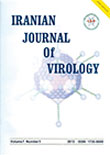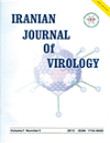فهرست مطالب

Iranian Journal of Virology
Volume:9 Issue: 3, 2015
- تاریخ انتشار: 1394/05/27
- تعداد عناوین: 6
-
-
Pages 1-5Background And AimsThe Cydia pomonella granulovirus (CpGV) is a baculovirus and very effective biological control agent against apple pest, codling moth, Cydia pomonella L. especially for healthy organic apple production and protection. Not only, screening of CpGV isolates via biochemical variation, but also their biological variation is practically necessary. However, the bioassay methods and biological activity parameters, such as LC50, LD50 and LT50 are different, sensitive and usually time and expense consuming; the right chosen method of bioassay can show differences and variation for applied screening purposes.Materials And MethodsIn this study, an appropriate double bioassay method have been successfully set to express biological variation of CpGV isolates on neonate larvae under laboratory conditions (26±0.2 ˚C, RH: 60%±2, 16:8 L: D). The diet incorporation bioassays (LC50) with 0 to 16000 occlusion bodies/ml usually determine the rate of larval mortality on 7th day.ResultsThe LC50 of CpGV isolates were evaluated 4454 to 2277 occlusion bodies (OBs) per ml of artificial diet.ConclusionsTthat show the double bioassay method have been successfully set and comparable with other results that can enhance biocontrol of codling moth especially in organic apple orchards.Keywords: codling moth, Cydia pomonella granulovirus, bioassay
-
Pages 6-14Background And AimsHerpes simplex virus (HSV) is a common cause of corneal disease and is the leading infectious cause of corneal blindness among developed nations. This study is aimed to provide an estimation of the incidence of Herpes Simplex Virustype-1, 2(HSV1, 2) and Varicella Zoster Virus (VZV) in tears and swab from eye infection by polymerase chain reaction (PCR) in eye disease in a suspected community.Materials And MethodsFifty subjects without signs of ocular herpetic disease enrolled in the study. Serum samples from all subjects were tested for HSV IgG antibodies by enzymelinked immunosorbent assay (ELISA). Subjects were instructed to collect tear samples by touching the inner surface of the lower eyelid with an individually wrapped, sterile cotton swab and to place the swab immediately into labeled sterile tubes. Swabs were kept at 4°C until processed. Nucleic acid was extracted from the samples and PCR-amplified for HSV DNA.ResultsAmong 50 samples, 3 samples were refused because internal controls were negative. HSV infection was established in 10% (5 out of 50) of all patients. The prevalence of HSV infection in patients with no clinical suspicion of herpetic keratitis was 6%. Histopathologic evaluation revealed that among samples with positive PCR results, 100% had evidence of inflammation, 55% had giant cells, 39% had necrosis, 59% had vascularization, 67 % had ulcer and 100% of them had inclusion bodies.ConclusionsBecause some of the patients with no clinical suspicion of herpes infection were found positive, we suggest that HSV to be considered as one of the underlying etiologies in any patient with corneal scar and keratitis. Therefore, performing further diagnostic methods, including PCR and histopathology, is mandatory to clearly understand the infection.Keywords: Herpes Simplex Virus, HSV-1, HSV-2, VZV, Tear, eye infection Polymerase Chain Reaction
-
Pages 15-23Background And AimsHop stunt viroid (HSVd, genus Hostuviroid, family Pospiviroidae) has a wide host range among trees and herbaceous plants. The objectives of this study were to compare biological and physical characteristics of three isolates of HSVd from mulberry, fig and citrus and search for other hosts of this viroid in Iran.Materials And MethodsPlant samples were collected from Yazd, Isfahan, Fars and Tehran provinces and examined for their possible infection by hop stunt viroid (HSVd) using reverse transcription- polymerase chain reaction (RT-PCR). The experimental host range of the viroid was determined by injection of infected sap into greenhouse grown seedlings and subsequent assay of inoculated plants by RT-PCR. Fig, mulberry and citrus isolates of the viroid were compared with respect to host range and molecular characteristics. Nucleic acids were isolated from plant tissues by CTAB method and subjected to RT-PCR using HSVd specific primers. The PCR products were sequenced and the most stable secondary structures for the three mentioned isolates were predicted and compared.ResultsAmong 120 samples collected from different regions and hosts, 13 samples from mulberry, fig, apple, quince, apricot, peach and citrus were infected by HSVd. The mulberry samples showed vein clearing and leaf deformation symptoms while usually no specific symptoms were observed in the fig samples. Apple, quince, apricot, peach and citrus samples were also symptomless hosts. In greenhouse tests, mulberry isolate induced more severe symptoms. Comparison of primary and secondary structures of the viroid isolates showed a closer similarity between the fig and mulberry isolates while the latter were less similar to citrus isolate.ConclusionsSequence variation and structural differences were observed amon the isolates studied. Most differences of these isolates were in the pathogenicity, variable and terminal right regions which may determine the type andseverity of symptoms. Many trees are infected without showing apparent symptoms.Keywords: hop stunt viroid, fig, citrus, mulberry
-
Pages 24-31Background And AimsCitrus exocortis disease is naturally limited to citrus plants and causes a serious disease on sensitive rootstocks such as trifoliate orange. The aim of this study was to sample new variants of citrus exocortis viroid from Fars trees with yellowing and suberization symptoms and comparison with other isolates of this viroid.Materials And MethodsA number of symptomatic or symptomless citrus trees were sampled and studied for viroid detection. After RNA extraction, reverse transcriptionpolymerase chain reaction was conducted and the full length genome of viroids were cloned and sequenced. Three CEVd isolates from Fars were selected and used for comparison with four CEVd isolates from Mazandaran and a number of other sequences from GenBank.ResultsIt was shown that on the basis of homology, three CEVd isolates from Mazandaran and all three CEVd isolates from Fars clustered into one group while one of the Mazandaran sequences fell apart.ConclusionsTherefore we proposed that Iranian CEVd isolates except one isolate from north have the same origin.Keywords: Viroid, CEVd, phylogeny, citrus viroids, citrus exocortis viroid
-
Pages 32-36Background And AimsNewcastle disease (ND) is a highly contagious disease that affects many species of birds and causes significant economic losses to the poultry industry worldwide and the pathogenicity of Newcastle disease virus (NDV) strains varies with different virulence. We aim to detect lentogenic (low virulence) ND virus (ND/IR 2010) using sentinel birds and molecular detection system in commercial broiler farms in Iran as the first molecular case.Materials And MethodsPartial sequencing of Fusion gene (F) which revealed that ND/IR 2010 carries the motif (112) GRQGRL (117) indicates that they are lentogenic genotype. Phylogenetic analysis, based on sequences of the F gene, revealed that our isolate should be classified as class II genotype I NDVs and related to the V4-like vaccine strain.ResultsSince the V4 vaccine strain is not used as vaccine in Iranian poultry industry, thus findings in this study are important and interesting. The results of alignment of gene showed that ND/IR 2010 has 99.9% amino acid homology with V4, I2 and some other lentogenic NDV from South East Asia (in particular to duck origin virus).ConclusionsThis study adds to the understanding of the ecology of ND viruses in Iran and emphasizes the need for constant surveillance for more focus on lentogenic strains and their role in commercial farms and water fowl population as a neglected viral infection agent.Keywords: Newcastle Disease Virus, Iran, Lentogenic, Phylogenetic study
-
Pages 37-43Background And AimsCervical cancer is among leading causes of cancer related death in women and human papilloma virus (HPV) is one of the important risk factor of this cancer. The aim of the present study was to develop a PCR method for identification of a high carcinogenic type of HPV, HPV 18 using E6 gene as a marker in patients with cervical cancerMaterials And Methods92 Formalin-Fix (FF) and Paraffin-Embedded (PE) tissues of premalignant and malignant lesions from cervical cancer patients were collected. DNA was extorted followed by PCR application in two steps using L1 and E6 consensus primers.ResultsInfection with HPV was observed in 68(73.91%) out of 92 samples by L1 region consensus primers, while 18 (26.47%) positive cases were detected to be HPV 18 using E6 type specific primer. Six of them were CINII and CINIII, and 12 cases were diagnosed as squamous cell carcinoma.ConclusionsOur findings demonstrated that the assessment of HPV18 using E6 gene with a specific PCR can help in identification of high carcinogenic genotypes of HPV. Further studies are needed to assess the value of this method in a larger multicenter setting for establishing their values for early detection of cervical cancer patients.Keywords: E6 papilloma virus, cervical cancer, HPV18


